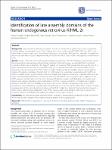Identification of late assembly domains of the human endogenous retrovirus-K(HML-2)
Chudak, Claudia
Beimforde, Nadine
George, Maja
Zimmermann, Anja
Lausch, Veronika
Hanke, Kirsten
Bannert, Norbert
Background: Late assembly (L)-domains are protein interaction motifs, whose dysfunction causes characteristic budding defects in enveloped viruses. Three different amino acid motifs, namely PT/SAP, PPXY and YPXnL have been shown to play a major role in the release of exogenous retroviruses. Although the L-domains of exogenous retroviruses have been studied comprehensively, little is known about these motifs in endogenous human retroviruses. Results: Using a molecular clone of the human endogenous retrovirus K113 that had been engineered to reverse the presumed non-synonymous postinsertional mutations in the major genes, we identified three functional L-domains of the virus, all located in the Gag p15 protein. A consensus PTAP tetrapeptide serves as the core of a main L-domain for the virus and its inactivation reduces virus release in HEK 293T cells by over 80%. Electron microscopy of cells expressing the PTAP mutant revealed predominantly late budding structures and budding chains at the plasma membrane. The fact that this motif determines subcellular colocalization with Tsg101, an ESCRT-I complex protein known to bind to the core tetrapeptide, supports its role as an L-domain. Moreover, two YPXnL motifs providing additional L-domain function were identified in the p15 protein. One is adjacent to the PTAP sequence and the other is in the p15 N-terminus. Mutations in either motif diminishes virus release and induces an L-domain phenotype while inactivation of all three L-domains results in a complete loss of particle release in HEK 293T cells. The flexibility of the virus in the use of L-domains for gaining access to the ESCRT machinery is demonstrated by overexpression of Tsg101 which rescues the release of the YPXnL mutants. Similarly, overexpression of Alix not only enhances release of the PTAP mutant by a factor of four but also the release of a triple mutant, indicating that additional cryptic YPXnL domains with a low affinity for Alix may be present. No L-domain activity is provided by the proline-rich peptides at the Gag C-terminus. Conclusions: Our data demonstrate that HERV-K(HML-2) release is predominantly mediated through a consensus PTAP motif and two auxiliary YPXnL motifs in the p15 protein of the Gag precursor.
No license information

